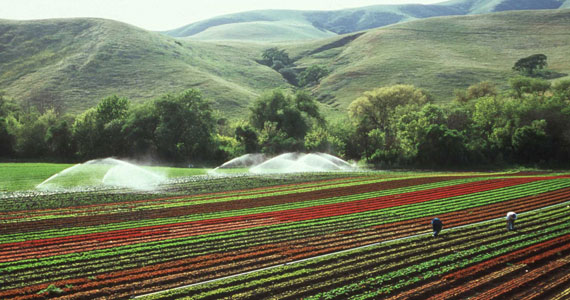California Makes Sustainable Agriculture a Priority

California agriculture's first sustainability progress report is in. The consensus: the Golden State is on track to meet key environmentally-friendly goals set by a coalition of farmers, ranchers, environmentalists, public health groups, food access nonprofit organizations and policy makers as part of the state-sponsored Ag Vision program. However, challenges still confront proponents of sustainable agriculture, notes the report.
Agriculture is booming. Farmers have earned record revenues over the past two years, with exports driving most of the economic growth in the sector. Recently it was learned that agriculture-heavy states have lower unemployment. But in the age of “sustainable development”, a rapidly expanding ag-industry raises some concerns about the environmental and human health impact of these otherwise welcome developments.
That's why the State Board of Food & Agriculture and the California Department of Food & Agriculture began a collaborative effort to identify long-term challenges facing food producers in the state. In 2008, the two agencies teamed up with the nonprofit conservation group American Farmland Trust (AFT) to find effective strategies to realize a set of goals and objectives gleaned from a series of brainstorming sessions with farmers, ranchers and other citizens. In December of 2010 – after a year of workshops, meetings and debates among the state's diverse agricultural representatives – a list of twelve action proposals was published in an AFT report titled, “California Agricultural Vision: Strategies for Sustainability” (or Ag Vision).
Ag Vision's strategies for a more sustainable food supply are as follows:
- Improve Access to Safe, Healthy Food for All Californians
- Ease the Burden of Regulation on Agriculture While Maintaining Health, Safety and Environmental Standards
- Secure an Adequate Supply of Water for Agricultural Purposes
- Assure a Strong Labor Force through Fairness to Agricultural Workers and Employers
- Effectively Detect, Exclude and Control Invasive Species
- Adopt a Policy of Conserving Agricultural Land and Water Resources
- Expand Environmental Stewardship on Farms and Ranches
- Promote Renewable Energy & Substitutes for Fossil-Based Inputs
- Assure Agricultural Adaptation to Climate Change
- Promote Robust Regional Markets for All California Producers
- Cultivate the Next Generation of Farmers and Ranchers
- Promote Agricultural Research that Anticipates 21st Century Challenges
A new report published by AFT last week provides an update on the status of 40Ag Vision initiatives, each of which was undertaken to implement one or more of the twelve strategies. The challenges faced by some of the initiatives require more than just agricultural expertise, concludes the new report. It recognizes that,
“as resourceful and resilient as California farmers and ranchers are, they cannot succeed in meeting these challenges on their own in a state whose population is overwhelmingly urban; that it will take cooperation and collaboration among the many interests, within and beyond agriculture, that have a stake in the production, availability and quality of our food.”
According to California Department of Food and Agriculture Secretary Karen Ross, Ag Vision is more than just a set of policy recommendations, “it is a platform for thoughtful engagement of diverse stakeholder views about our food and agriculture system; and, it is a call for leadership by all those concerned about the future of California agriculture and its continued critical role in our state.”
In the report, Ross emphasized the primary role farmers and ranchers will play in the realization of Ag Vision. California, the nation's top agriculture producer, intends to keep its farms profitable and increasingly competitive in the international marketplace. These goals, according to Ross, will be achieved in large part by recognizing that working lands in the state have more to offer “beyond the production of food and fiber to include benefits for our environment, health systems, and energy sectors”. Capturing this opportunity through innovative policy that is informed from the ground up through local Farm Bureaus, regional food policy collaboratives and general plan work groups is key to agriculture's contribution to Ag Vision, said Ross.
California State Board of Food and Agriculture president Craig McNamara offered his insights in the report. He explains why agriculture needs to cooperate with other food-interested groups if a sustainable-ag future is to be realized.
“Whether it is dealing with government regulation, water and labor shortages, invasive species or the constant creep of urbanization on farmland, California agriculture must unite its own diverse sectors and join with others who have a stake in our food system. It must rethink its response to the challenges it faces and come up with new solutions that enjoy the kind of broad public consensus that will make their implementation easier than it seems to be these days."
To read more about Ag Vision and to offer your feedback on the project, visit the American Farmland Trust blog, or find out more online at California Department of Food and Agriculture's Ag Vision website.




